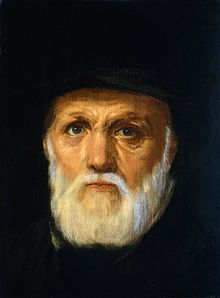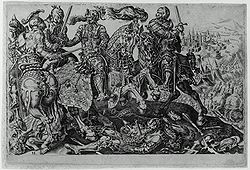- Dirck Volckertszoon Coornhert
-
Dirck Volckertszoon Coornhert 
Portrait of Dirck Volckertszoon Coornhert by Cornelis van Haarlem.Birth name Dirck Volckertszoon Born 1522
AmsterdamDied October 29, 1590 (aged 68)
GoudaField Writing, Philosophy, Theology, Engraving Movement Humanism Dirck Volckertszoon Coornhert (1522–1590) was a Dutch writer, philosopher, translator, politician and theologian. Coornhert is often considered the Father of Dutch Renaissance scholarship.
Biography
He was the youngest son of Volckert Coornhert, an Amsterdam cloth merchant. As a child he spent some years in Spain and Portugal. Returning home, he was disinherited by his father's will, for his marriage with Cornelia (Neeltje) Simons, a portionless gentlewoman from Haarlem, whose sister was Anna Simonsdr, the mistress of Reginald (Reinoud), count of Brederode (they were the parents of Lucretia van Brederode). Through his sister-in-law, he became major-domo to Reginald at his castle in Vianen for a short time. Soon after that, he bought a house in his wife's home town of Haarlem on the St. Janssteeg from Anna and her husband Jan. Though he started off working for Reginald, he lived near the school where the St. Jan commanderij taught classic works and commissioned art. Maarten van Heemskerck had just returned from Italy and impressed Coornhert with his work. Coornhert became an engraver on copper, and produced works in collaboration with Heemskerck which became popular.[1]
 Charles V conquers Tunisia, one of a series of prints drafted by Heemskerck and engraved by Coornhert. This series was noted by Karel van Mander in his Schilderboeck.[1]
Charles V conquers Tunisia, one of a series of prints drafted by Heemskerck and engraved by Coornhert. This series was noted by Karel van Mander in his Schilderboeck.[1]
Learning Latin, he published Dutch translations from Cicero, Seneca and Boethius. His 1562 translation of the first twelve books of Homer's Odyssey is one of the first major works of Dutch Renaissance poetry. He was appointed secretary to the city (1562) and secretary to the burgomasters (1564). Throwing himself into the struggle against Spanish rule, he drew up the manifesto of William the Silent, Prince of Orange (1566). Imprisoned at the Hague in 1568, he escaped to Cleves, where he maintained himself by his art. Recalled in 1572, he was secretary of state for a short time; his aversion to military violence led him to return to Cleves, where William continued to employ his services and his pen. As a religious man, he wrote and strove in favor of tolerance, opposing capital punishment for heretics. He had no party views; he criticized the Heidelberg Catechism, which was authoritative in Holland. Jacobus Arminius, employed to refute him, was won over by his arguments.
According to the RKD, his pupils were Hendrick Goltzius, Philip Galle, and Cornelis Cort.[2]
On his death in 1590, his Dutch version of the New Testament, following the Latin of Erasmus, was never completed. His works, in prose and verse, were published in 1630 in 3 volumes.
Quotes[3]
- "Each wants to dictate another's creed ... This is done by those who formerly taught that such things do not become the Christian"
- "Rest Elsewhere" (his motto).
- "...a voluntary crowbar to the murderous prison of conscience" (on himself).
References
- ^ a b Biography of Coornhert by Ilja M. Veldman, Zutphen, 1989, in the DBNL (with prints)
- ^ Dirck Volckertsz. Coornhert in the RKD
- ^ 'Frans Hal Museum Haarlem - Dutch Painting' - Baard, Henricus Petrus, trans. J.J.Kliphuis - Knorr & Hirth Verlag GMBH, 1967
- F. D. J. Moorrees, Dirck Volckertszoon Coornhert (1887)
- N. Delvenne, Biog. des Pays-Bas (1829); A. J. van der Aa, B-tog.
- Woordenboek der Nederlanden (1855). (A. Go.*)
- Henk Bonger, The Life and Work of Dirck Volkertszoon Coornhert (Amsterdam: G. A. van Oorschot, 1978), Trans. into English by Gerrit Voogt (Amsterdam - New York: Rodopi, 2004.
 This article incorporates text from a publication now in the public domain: Chisholm, Hugh, ed (1911). Encyclopædia Britannica (11th ed.). Cambridge University Press.Categories:
This article incorporates text from a publication now in the public domain: Chisholm, Hugh, ed (1911). Encyclopædia Britannica (11th ed.). Cambridge University Press.Categories:- 1522 births
- 1590 deaths
- Dutch theologians
- Dutch Renaissance humanists
- Dutch engravers
- Dutch translators
- Dutch dramatists and playwrights
- Dutch poets
- Dutch politicians
- People from Amsterdam
- Renaissance engravers
Wikimedia Foundation. 2010.
